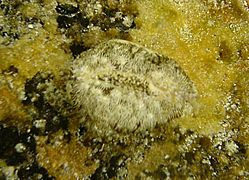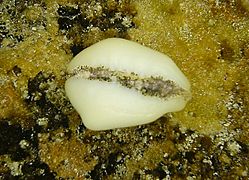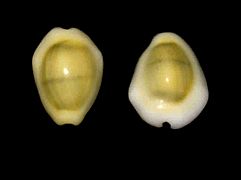Money cowrie facts for kids
The money cowry (scientific name: Monetaria moneta) is a small type of sea snail. It's a marine mollusk from the cowry family, known as Cypraeidae.
This snail is called the "money cowry" because its shells were used as shell money in many parts of the Pacific and Indian Ocean long ago. People used them for trading before coins became common.
Quick facts for kids Money cowry |
|
|---|---|
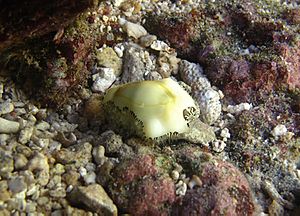 |
|
| Live animal, with mantle visible | |
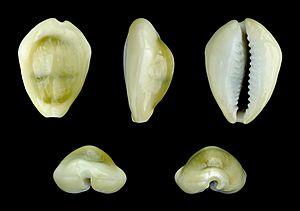 |
|
| Five views of a shell of Monetaria moneta | |
| Scientific classification | |
| Kingdom: | |
| Phylum: | |
| Class: | |
| (unranked): |
clade Caenogastropoda
clade Hypsogastropoda clade Littorinimorpha |
| Superfamily: |
Cypraeoidea
|
| Family: | |
| Genus: |
Monetaria
|
| Species: |
M. moneta
|
| Binomial name | |
| Monetaria moneta (Linnaeus, 1758)
|
|
Contents
What the Money Cowry Looks Like
The money cowry is a small sea snail. Its shell is usually about 3 cm (1.2 in) long. The shell is not perfectly round; it's a bit flat and has strong, thick edges. It often looks like a rough hexagon.
The shell's color is usually light, from white to a dull beige. The top part often looks clear, sometimes greenish-grey with yellowish edges. You might even see faint darker stripes across it. The opening of the shell is wide and white, with many small teeth-like bumps.
When the snail is alive, its soft body part, called the mantle, is spotted with black and off-white colors. The shells of Monetaria moneta can look very different in shape and color. Because of these differences, some of them were once thought to be completely different species!
Where Money Cowries Live
This snail is very common and can be found in warm, tropical waters of the Indo-Pacific region. You can find them in many places, including:
- East and South Africa
- Madagascar
- The Red Sea and Persian Gulf
- The Maldives
- Eastern Polynesia
- The Galápagos Islands
- Clipperton Island and Cocos (Keeling) Islands near Central America
- Southern Japan
- Midway Atoll and Hawaii
- Northern New South Wales and Lord Howe Island in Australia
Money Cowry Habitat
Money cowries like to live in intertidal areas. These are rocky places along the coast that are covered by water at high tide and exposed at low tide. They are often found in shallow tide pools.
You can spot them among seaweed, pieces of old coral, and empty bivalve shells. They live on and under rocks in shallow water. When the tide is low, you might see them on exposed reefs. They eat algae and other marine plants that grow on loose rocks and dead coral pieces.
How People Use Money Cowries
People use the shells of money cowries in different ways. They are often used to make jewelry and other decorations. You might see them on baskets or hanging on walls as art.
As Money
For a long time, the shells of the money cowry were used as a way to trade goods and services. This happened in many parts of Africa, Asia, and the Pacific islands. This practice continued until the late 1800s.
The Maldives islands were a main source for these cowrie shells. From there, they were traded across Asia and along the coast of East Africa. A huge number of Maldivian cowries were brought to Africa by slave traders. European settlers also traded these shells with Native Americans.
For Divination
In some African religions, the money cowry shell is still used in special rituals to predict the future. This is called divination.
In the state of Kerala, India, special money cowry shells are used for divination in Hindu astrology. These shells are known as Kavidi (കവിടി) in the Malayalam language. For a ritual called Prashnam, 108 Kavidi shells are moved around. People ask for blessings from God and their Guru. Then, some of the shells are separated and counted to find out which planet is important at that moment. The results from the shells are compared with a person's horoscope to make predictions.
See also
 In Spanish: Monetaria moneta para niños
In Spanish: Monetaria moneta para niños


